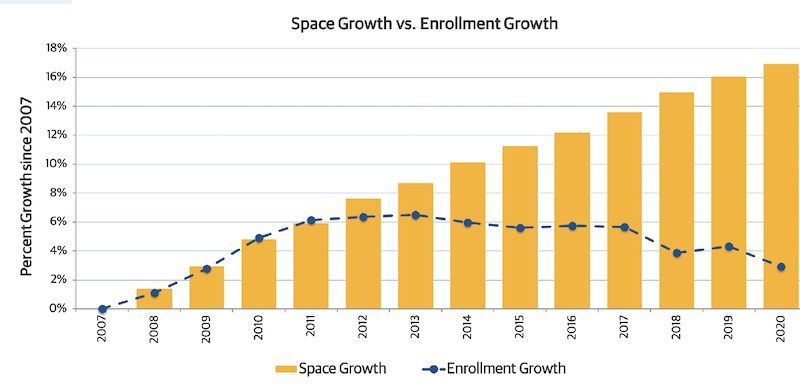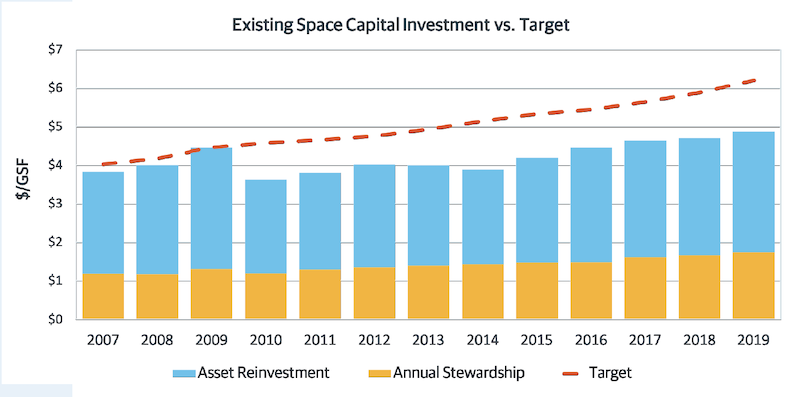As a result of the coronavirus pandemic, higher education is confronting its history of questionable facilities investment decisions and an unprecedented transformation on campuses that has made it imperative to reimagine construction, space allocation, and sustainability.
Gordian, a leading provider of facility and construction cost data, software, and services, analyzes the complexities of this transformation in the latest edition of its State of Facilities in Higher Education report, which this year Gordian conducted with APPA, an organization that represents more than 18,000 educational facilities professionals from over 1,300 learning institutions.
The report advocates for the increasing relevance of facilities managers at a time when campuses are building more space (schools in Gordian’s database were up 16% since 2007), but have also ill-advisedly deferred renovation on existing buildings, to the point where their backlog of asset renewal has increased by 35% since 2007, and their investment shortfall grew to 25%.

Colleges in Gordian's database have increased their space by 16% since 2007, but their student enrollment has increased only 2%. Images: Gordian and APPA
HOW MUCH SPACE WILL BE REQUIRED?
The pandemic has disrupted institutional improvement budgets by reducing student enrollment and shifting learning to remote and digital platforms that have lessened the need for campus spaces such as offices, dining halls, and residences. Outdoor spaces “were the rare bright spot, when weather has allowed,” the report states.
Consequently, campus planners are raising questions about what kinds of spaces will be needed in the future, and why. But adaptively reusing campus space is easier said than done. “Facilities offices aren’t sized and organized to maintain, clean and renovate according to student and staff activity. Rather, these offices maintain campus buildings independent of activity level,” the report observes.
Finding ways to fund facilities improvements and upgrades won’t be simple, either. The American Council on Education projects that the industry needs at least $180 billion to offset revenue losses and COVID-related expenses to maintain safe operations during the pandemic. But with between 50% and 70% of campus expenditures earmarked for employee compensation, the opportunities for addressing budget shortfalls without touching staffing are limited. For the whole of 2020, the industry lost 650,000 jobs.

Backlogs of campuses' asset renewal needs have grown to $106 per gross sf, and 35% increase since 2007.
WHAT DOES ‘COMMUNITY’ MEAN TODAY?
The report notes that in the 2020 fall semester, 44% of schools were fully or primarily online, with another 21% operating in hybrid teaching mode. However, Gordian and APPA contend that the virtual world is not yet able to replace the in-person [educational] experience. “Community continues to be reliant on the physical gatherings of people, which will be an expected element of the collegiate experience for some time to come.”
If schools can’t provide this meaningful engagement, as well as some demonstrable evidence of a return on students’ investment, enrollments will continue to drop. The 13% decline in last year’s incoming freshman class “will have a ripple effect across the next three to five years,” the report states.
And schools can no longer rely on international students to help bridge their financial gaps.
The whole concept of campus “community” is changing. And the sudden embrace of digital tools for teaching opens endless interpretations of what an academic community looks like. “An opportunity clearly exists to reimagine campus space. The window is open to embrace digital, distant and trust-based work environments, and [schools] should leap to take advantage of the moment.”
More to the point, “the data say we need to use less space because [schools] simply can’t care for what [they’ve] built,” says the report.

The investment shortfall in existing campus facilities has grown to 25% over the past 13 years.
HARD CHOICES WILL BE NECESSARY
So what are colleges and universities to do?
A start would be to document real operating costs, including the accrual of deferred needs with altered staffing and reduced capital investment. Facilities managers must prioritize space going forward, and clarify how students are likely to be taught. “Create a coherent narrative, incorporating the expectations of the community and the demands of the facilities, that represents a shared agreement for how to best optimize service to academic aspirations and institutional mission.”
Regarding future investments, schools must define their risk tolerances, especially it comes to keeping building systems operable to avoid shutdowns. Finance and facilities leaders must jointly understand how best to invest in a school’s physical plant, and develop a suitable investment strategy based on future need. That strategy, states the report, should have buy-in from the school’s senior leadership as well as stakeholders—students, faculty, workers—who will be affected by those decisions.
To meet the challenges of more dynamic campuses with fluid spaces and use, the report suggests that, at a minimum, institutions need to honestly appraise their facilities management teams, and determine what skills they will need for the next crisis but also routine times.
“Assess the type or work that has been required and is anticipated to be required to match hiring practices with the skills of the future,” the report states.
Related Stories
| Dec 17, 2010
Alaskan village school gets a new home
Ayagina’ar Elitnaurvik, a new K-12 school serving the Lower Kuskikwim School District, is now open in Kongiganak, a remote Alaskan village of less than 400 residents. The 34,000-sf, 12-classroom facility replaces one that was threatened by river erosion.
| Dec 17, 2010
New engineering building goes for net-zero energy
A new $90 million, 250,000-sf classroom and laboratory facility with a 450-seat auditorium for the College of Electrical and Computer Engineering at the University of Illinois at Urbana/Champaign is aiming for LEED Platinum.
| Dec 17, 2010
How to Win More University Projects
University architects representing four prominent institutions of higher learning tell how your firm can get the inside track on major projects.
| Dec 6, 2010
Honeywell survey
Rising energy costs and a tough economic climate have forced the nation’s school districts to defer facility maintenance and delay construction projects, but they have also encouraged districts to pursue green initiatives, according to Honeywell’s second annual “School Energy and Environment Survey.”
| Nov 29, 2010
New Design Concepts for Elementary and Secondary Schools
Hard hit by the economy, new construction in the K-12 sector has slowed considerably over the past year. Yet innovation has continued, along with renovations and expansions. Today, Building Teams are showing a keener focus on sustainable design, as well as ways to improve indoor environmental quality (IEQ), daylighting, and low-maintenance finishes such as flooring.
| Nov 23, 2010
Honeywell's School Energy and Environment Survey: 68% of districts delayed or eliminated improvements because of economy
Results of Honeywell's second annual “School Energy and Environment Survey” reveal that almost 90% of school leaders see a direct link between the quality and performance of school facilities, and student achievement. However, districts face several obstacles when it comes to keeping their buildings up to date and well maintained. For example, 68% of school districts have either delayed or eliminated building improvements in response to the economic downturn.
| Nov 9, 2010
Just how green is that college campus?
The College Sustainability Report Card 2011 evaluated colleges and universities in the U.S. and Canada with the 300 largest endowments—plus 22 others that asked to be included in the GreenReportCard.org study—on nine categories, including climate change, energy use, green building, and investment priorities. More than half (56%) earned a B or better, but 6% got a D. Can you guess which is the greenest of these: UC San Diego, Dickinson College, University of Calgary, and Dartmouth? Hint: The Red Devil has turned green.
| Nov 3, 2010
First of three green labs opens at Iowa State University
Designed by ZGF Architects, in association with OPN Architects, the Biorenewable Research Laboratory on the Ames campus of Iowa State University is the first of three projects completed as part of the school’s Biorenewables Complex. The 71,800-sf LEED Gold project is one of three wings that will make up the 210,000-sf complex.
| Nov 3, 2010
Park’s green education center a lesson in sustainability
The new Cantigny Outdoor Education Center, located within the 500-acre Cantigny Park in Wheaton, Ill., earned LEED Silver. Designed by DLA Architects, the 3,100-sf multipurpose center will serve patrons of the park’s golf courses, museums, and display garden, one of the largest such gardens in the Midwest.
| Nov 3, 2010
Seattle University’s expanded library trying for LEED Gold
Pfeiffer Partners Architects, in collaboration with Mithun Architects, programmed, planned, and designed the $55 million renovation and expansion of Lemieux Library and McGoldrick Learning Commons at Seattle University. The LEED-Gold-designed facility’s green features include daylighting, sustainable and recycled materials, and a rain garden.














